Strategies for Robust Risk Management in Global Supply Chains
At KnoWerX, we recognize that in today’s interconnected global economy, businesses rely heavily on complex international networks to source materials, manufacture products, and deliver goods to customers worldwide. These intricate systems, however, are susceptible to a wide array of threats that can disrupt operations, impact financial performance, and damage reputations. Therefore, risk management in global supply chains has become a critical competency for organizations seeking to maintain resilience and continuity amid uncertainty.
Risk management in global supply chains refers to the systematic process of identifying, assessing, and mitigating potential threats to supply chain operations. The significance of robust risk management strategies cannot be overstated, as they enable companies to proactively address challenges, minimize disruptions, and maintain a competitive edge in an increasingly volatile business environment.
The challenges facing global supply chains are numerous and diverse, ranging from natural disasters and geopolitical tensions to cybersecurity threats and regulatory changes. Developing comprehensive risk management strategies is essential for organizations to successfully navigate the complexities of international trade and logistics. At KnoWerX, we equip supply chain professionals with the knowledge and skills needed to develop and implement these crucial strategies, ensuring their organizations can thrive even in the face of global uncertainties
Types of Risks in Global Supply Chains

To effectively implement risk management in global supply chains, it’s crucial to understand the various types of threats that can impact operations:
Operational risks: These include disruptions to day-to-day activities such as transportation delays, quality control issues, and equipment failures. Effective risk management in global supply chains must address these common but potentially costly disruptions.
Financial risks: Currency fluctuations, changes in commodity prices, and supplier bankruptcies fall under this category. Risk management in global supply chains should include strategies to mitigate financial exposure.
Geopolitical risks: Trade disputes, sanctions, and political instability can significantly impact supply chain operations across borders. A robust approach to risk management in global supply chains must account for these complex international factors.
Environmental risks: Natural disasters, climate change impacts, and resource scarcity pose increasing threats to global supply chains. Incorporating environmental considerations into risk management strategies for global supply chains is becoming increasingly important.
Technological risks: Cybersecurity breaches, system failures, and obsolescence of technology can disrupt supply chain operations and compromise sensitive data. As supply chains become more digitized, addressing technological risks is a critical component of risk management in global supply chains.
Risk Identification and Assessment

Effective risk management in global supply chains begins with thorough identification and assessment of potential threats:
Risk mapping techniques: Visual tools like heat maps and bow-tie diagrams help organizations identify and prioritize risks across their supply chains. These techniques are essential for comprehensive risk management in global supply chains.
Quantitative and qualitative risk analysis: Combining data-driven assessments with expert judgments provides a comprehensive view of risk exposure. This balanced approach is key to effective risk management in global supply chains.
Key risk indicators (KRIs): Establishing and monitoring KRIs enables early detection of emerging threats and trends. KRIs are a crucial tool for proactive risk management in global supply chains.
Scenario planning and stress testing: These techniques help organizations prepare for various potential outcomes and assess their resilience to different risk scenarios. They are invaluable for developing robust risk management strategies in global supply chains.
Risk Mitigation Strategies
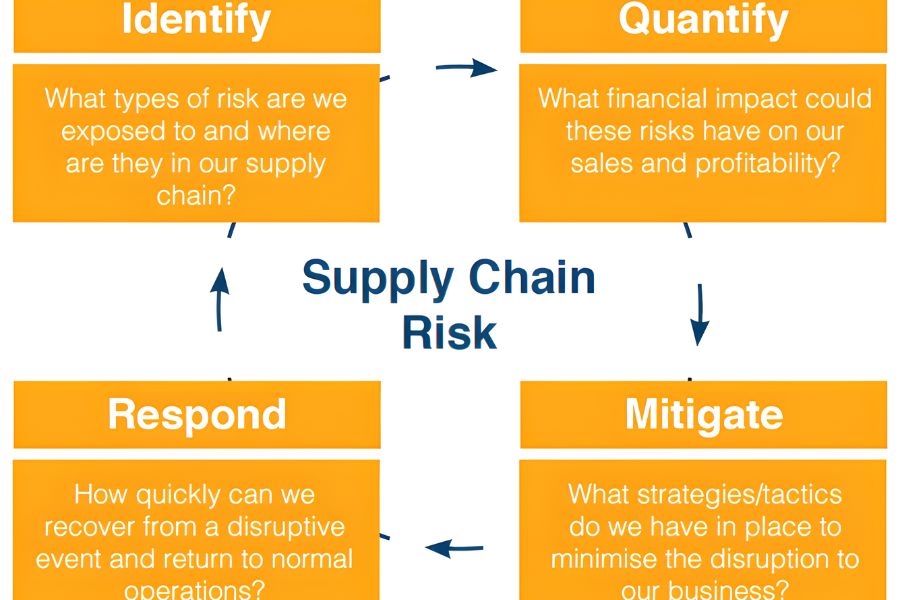
Once risks are identified and assessed, organizations can implement various strategies to mitigate them. Effective risk management in global supply chains often involves a combination of the following approaches:
Diversification of suppliers and markets: Reducing dependence on single sources or regions can enhance supply chain resilience. This strategy is a fundamental aspect of risk management in global supply chains.
Building flexibility and redundancy: Developing alternative supply routes, production facilities, and logistics options provides backup plans in case of disruptions. Flexibility is a key principle of effective risk management in global supply chains.
Implementing robust inventory management: Balancing stock levels to buffer against shortages while avoiding excess inventory costs is crucial for risk management in global supply chains.
Developing contingency plans: Creating detailed response plans for various risk scenarios ensures rapid and effective action when disruptions occur. Contingency planning is an essential component of risk management in global supply chains.
Leveraging technology for risk monitoring: Advanced analytics, artificial intelligence, and IoT devices can provide real-time insights into supply chain risks and enable proactive management. Technology plays an increasingly important role in risk management for global supply chains.
Supply Chain Visibility and Transparency

Enhancing visibility across the entire supply chain is crucial for effective risk management in global supply chains:
Importance of end-to-end visibility: Clear insight into all supply chain stages allows for better risk identification and faster response to disruptions. Improving visibility is a key objective of risk management in global supply chains.
Technologies for enhancing transparency: Blockchain and IoT devices can provide secure, real-time tracking of goods and information throughout the supply chain. These technologies are revolutionizing risk management approaches in global supply chains.
Data analytics for risk prediction and management: Advanced analytics tools can process vast amounts of data to identify patterns, predict potential risks, and suggest mitigation strategies. Data-driven decision-making is becoming central to risk management in global supply chains.
Collaborative Risk Management
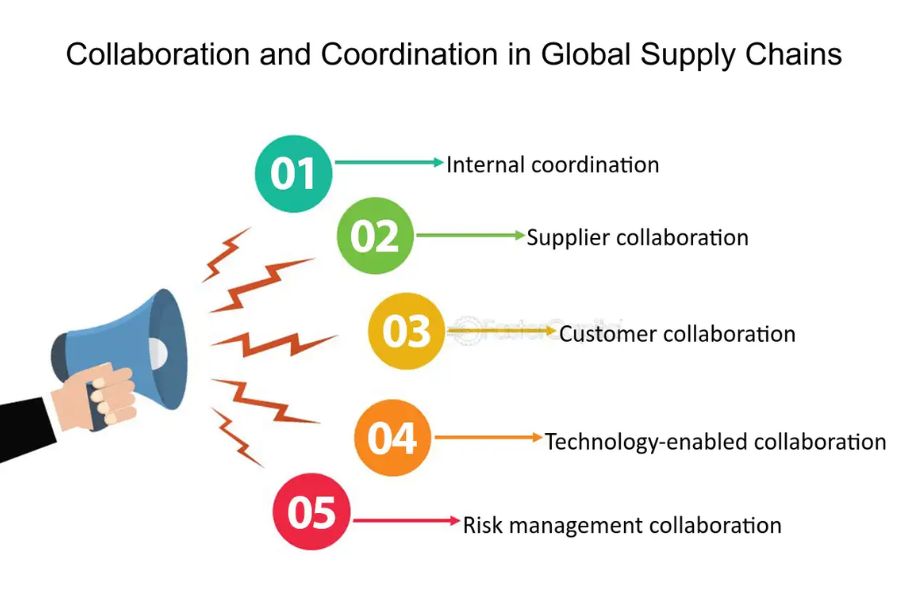
Effective risk management in global supply chains often requires cooperation across the entire network:
Strengthening supplier relationships: Building trust and open communication with suppliers can lead to better risk sharing and joint problem-solving. Strong relationships are a cornerstone of successful risk management in global supply chains.
Information sharing across the supply chain: Transparent exchange of risk-related information can improve overall supply chain resilience. Information sharing is crucial for comprehensive risk management in global supply chains.
Joint risk mitigation efforts with partners: Collaborating on risk management initiatives can lead to more comprehensive and effective strategies. Partnership is increasingly important in risk management for global supply chains.
Regulatory Compliance and Risk Management
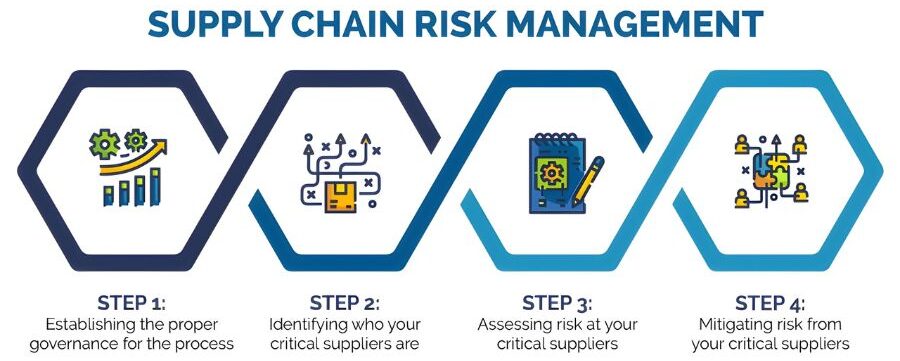
Navigating the complex landscape of international regulations is a crucial aspect of risk management in global supply chains:
Understanding global regulations and standards: Staying informed about diverse regulatory requirements across different markets is essential for compliance. Regulatory awareness is a key component of risk management in global supply chains.
Developing compliance frameworks: Creating systematic approaches to ensure adherence to various regulations and standards is necessary for effective risk management in global supply chains.
Managing legal and reputational risks: Proactively addressing compliance issues to avoid legal penalties and protect brand reputation is an important aspect of risk management in global supply chains.
Building a Risk-Aware Culture
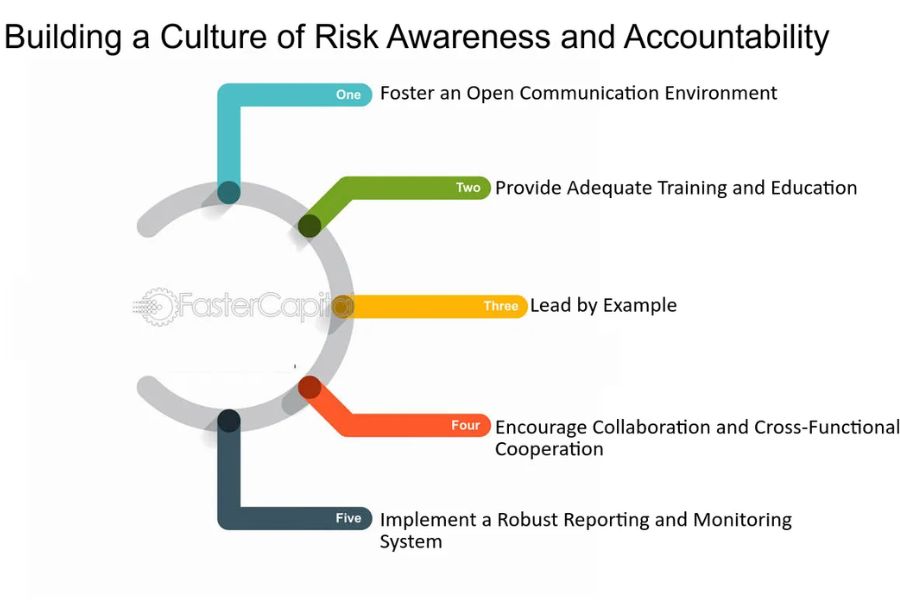
Embedding risk management into organizational culture is key to long-term success in managing global supply chain risks:
Training and education programs: Regular training sessions can help employees at all levels understand and contribute to risk management efforts. Education is crucial for fostering a culture of risk awareness in global supply chains.
Integrating risk management into decision-making processes: Ensuring that risk considerations are part of all major business decisions is essential for effective risk management in global supply chains.
Encouraging proactive risk reporting and management: Creating an environment where employees feel comfortable reporting potential risks and suggesting improvements can significantly enhance risk management in global supply chains.
Measuring and Monitoring Risk Management Effectiveness
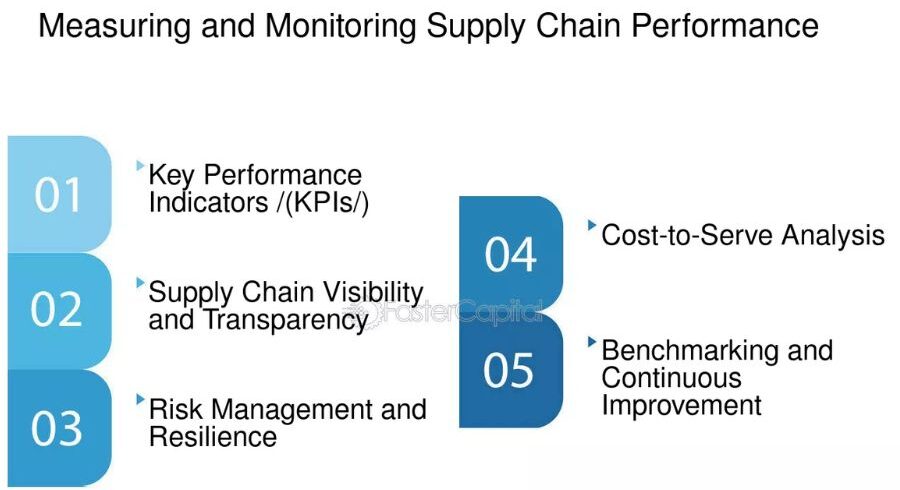
Continuous evaluation and improvement of risk management strategies is essential for maintaining resilient global supply chains:
Key performance indicators (KPIs) for risk management: Establishing metrics to assess the effectiveness of risk management initiatives helps organizations track their progress and identify areas for improvement.
Continuous improvement processes: Regularly reviewing and updating risk management strategies based on performance and changing conditions ensures that approaches remain relevant and effective.
Regular risk audits and assessments: Conducting thorough reviews of risk management practices helps identify areas for improvement and ensures that strategies remain aligned with organizational goals and the evolving risk landscape.
Case Studies in Risk Management for Global Supply Chains
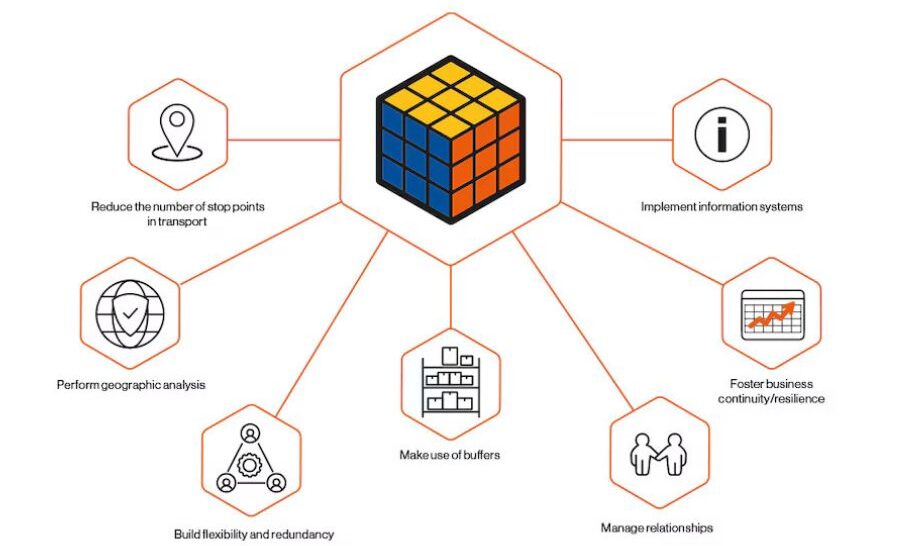
Examining real-world examples can provide valuable insights for improving risk management in global supply chains:
Successful risk management implementations: Analysing cases where organizations effectively mitigated supply chain risks can offer practical lessons for others seeking to enhance their risk management strategies.
Lessons learned from supply chain disruptions: Studying major supply chain failures can help identify common pitfalls and best practices for risk management in global supply chains.
For example, the COVID-19 pandemic highlighted the importance of supply chain resilience and the need for robust risk management strategies. Many companies that had invested in diversifying their supplier base and implementing advanced risk monitoring technologies were better able to navigate the disruptions caused by the pandemic.
Another illustrative case is that of a major automotive manufacturer that implemented a comprehensive risk management program for its global supply chain. By using advanced analytics to identify potential risks and developing collaborative relationships with key suppliers, the company was able to significantly reduce supply chain disruptions and improve overall operational efficiency.
FAQs: Frequently Asked Questions
What is risk management in global supply chains?
Risk management in global supply chains refers to the systematic process of identifying, assessing, and mitigating potential threats that can disrupt supply chain operations, impact financial performance, and damage reputations.
Why is risk management in global supply chains important?
Robust risk management strategies enable companies to proactively address challenges, minimize disruptions, and maintain a competitive edge in an increasingly volatile business environment.
What types of risks can affect global supply chains?
Global supply chains face various risks, including operational risks (e.g., transportation delays, equipment failures), financial risks (e.g., currency fluctuations, supplier bankruptcies), geopolitical risks (e.g., trade disputes, political instability), environmental risks (e.g., natural disasters, climate change), and technological risks (e.g., cybersecurity breaches, system failures).
How can organizations identify and assess risks in their supply chains?
Organizations can use risk mapping techniques, quantitative and qualitative risk analysis, key risk indicators (KRIs), and scenario planning and stress testing to identify and assess potential threats.
What are some common risk mitigation strategies for global supply chains?
Common risk mitigation strategies include diversifying suppliers and markets, building flexibility and redundancy, implementing robust inventory management, developing contingency plans, and leveraging technology for risk monitoring.
End Notes
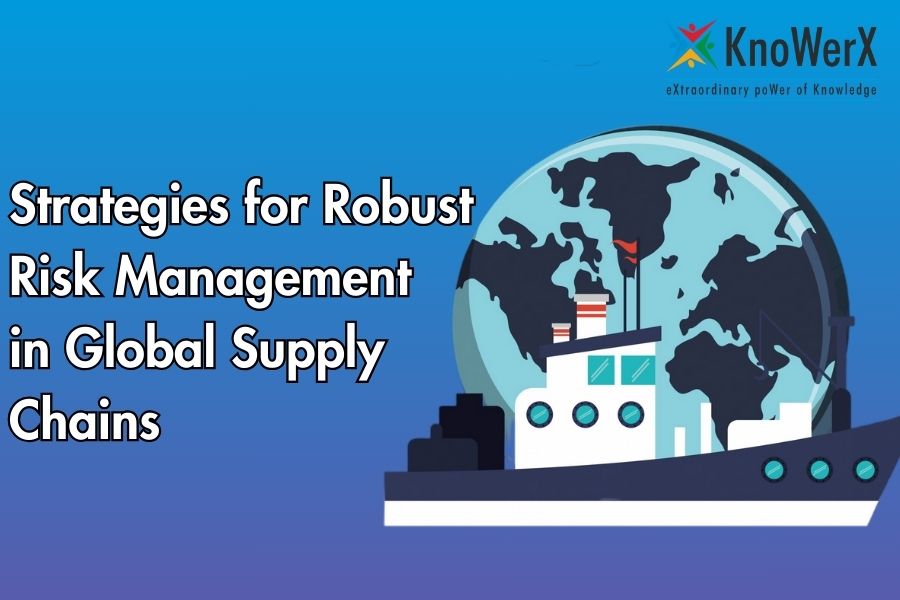
At KnoWerX, we understand that robust risk management in global supply chains is not merely an option but a necessity for businesses navigating today’s intricate and unpredictable environment. By implementing comprehensive strategies that encompass risk identification, assessment, mitigation, and continuous improvement, organizations can enhance their resilience and maintain a competitive edge.
Key strategies for effective risk management in global supply chains include diversifying suppliers, enhancing supply chain visibility, leveraging advanced technologies, fostering collaborative relationships, ensuring regulatory compliance, and building a risk-aware organizational culture.
Looking ahead, the field of risk management in global supply chains is poised to evolve with advancements in technology, shifts in global trade dynamics, and emerging environmental challenges. Organizations that prioritize and invest in robust risk management practices will be better positioned to navigate these changes and thrive in the global marketplace.
At KnoWerX, we believe businesses must take action now by implementing comprehensive risk management practices to safeguard their global supply chains against current and future threats. By doing so, they can ensure operational continuity, financial stability, and long-term success in an increasingly interconnected and volatile global economy. Our curriculum course covers all-encompassing risk management strategies, which we deem essential for successfully navigating the intricacies of international trade and logistics



